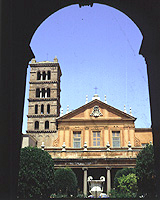St. Cecilia in Trastevere
 A tranquil spot with ancient fountain and lilies in the garden, and a superb fresco of multicolored winged angels in the Convent.
A tranquil spot with ancient fountain and lilies in the garden, and a superb fresco of multicolored winged angels in the Convent.
St. Cecilia, a noblewoman, died a horrible death on this spot in her own home: first they tried to suffocate her in her private steam baths. She emerged refreshed - having done a lot of singing, for which she became patron saint of music.
Then an executioner tried to chop of her head; he botched the job so badly, she lingered on for three days, converting many to Christianity before she died.
The experts differ on which Emperor was reigning: Marcus Aurelius (161-180 AD), or Alexander Severus (222-236 AD), or Diocletian (284-303 AD). Take your pick.
A shrine was built to her in this house in the 5C (though her body and that of her husband St. Valerian who also died a martyr's death, had been buried at the St. Calixtus Catacombs, outside the Walls (the Roman rule was no dead bodies within the precincts of the city, for health reasons).
Pope Paschal I searched all over the place for her tomb, and in 820 AD they found it in the Catacombs, disinterred her body and that of her husband and brought them back to their house, making a church over the burial crypt.
The baroque facade was remodeled centuries later, but the 12C porch and mosaics were kept.
The bell tower, leaning slightly, is from the same epoch.
Inside are some mosaics (9C); St. Paschal is depicted with a square halo, showing he was still alive; a baldachin over the altar (di Cambio 1293); a tomb of an English Cardinal Adam Easton (d.1393); and in the crypt, don't miss the statue (Maderna 1599) sculpted from St. Cecilia's corpse. (They opened the tomb to see if it really was Cecilia.) They are buried in the same steam baths where she survived the first attempt on her life (note the heating tubes on the wall.)
Not to be missed are the stupendous fresco remnants (Pietro Cavallini 1293) - he did the mosaics in St. Maria in Trastevere. The angels' wings, graduated multicolored feathers in pinks and reds, and the figures in their pleated robes are gorgeous.